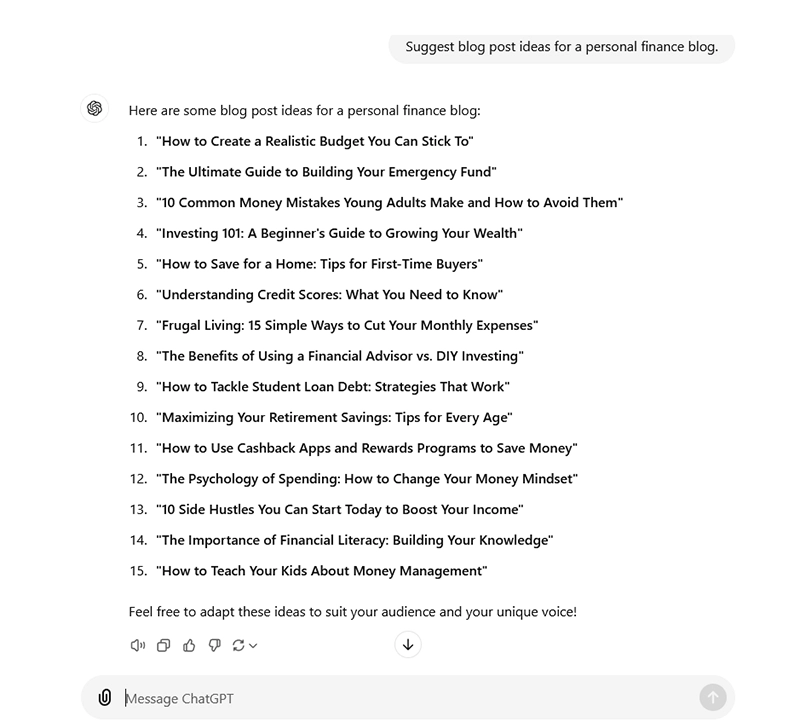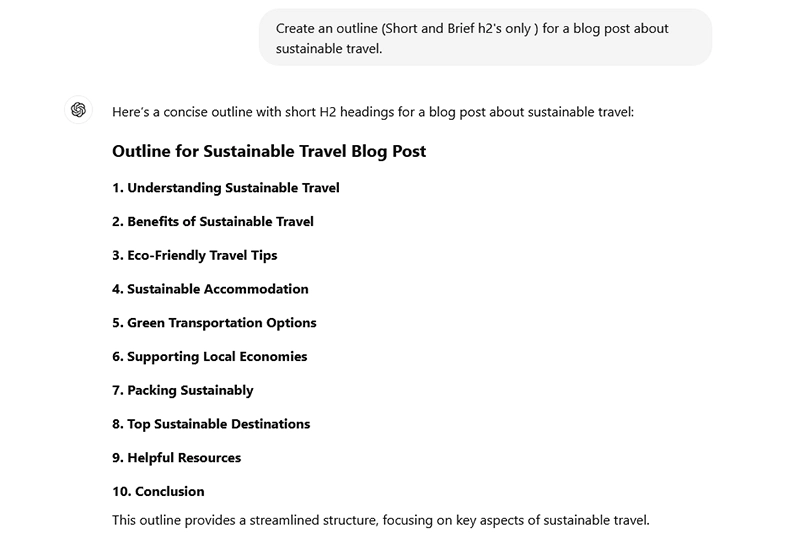You don’t have to be a professional prompt scientist to use chat GPT for blogging.
But the surprising thing is that 99% of bloggers waste their money purchasing paid AI tools to generate content for their businesses and blogs.
In fact, I have researched and found that almost 80% of the top-ranked blog pages in Google are being created with the help of chatGPT, and they are getting ranked on Google’s first page, too.
In this comprehensive guide, I’ll explore how to use ChatGPT for blogging to save time, boost productivity, and create high-quality content that connects with your readers.
How To Use ChatGPT For Blogging
So, without further ado, let’s show you the endless possibilities of chatGPT and how you can create content with the help of this AI language processing tool.
Step#1: Humanize Your Chat Page
Before generating a piece of content, the first step is to humanize your chat page so that your blog article will look professional and human-generated.
This chat humanization will help your readers understand you are writing for them, and they will be interested in your human-like writing and connect with your posts.
Open your new chat page and write.
” You are one of the best blog post writers, and you will write like the style I follow, the wording, the tone I follow, the way I connect with my blog readers. So will you follow my previously published URL and grab the style?”

After receiving ChatGPT’s acknowledgement, provide a URL to an old blog post or your About page. This helps ChatGPT understand your writing purpose, audience, and the ways your content supports visitors’ needs.
Next, you will write this prompt to get the best result before writing any blog post or generating ideas from that page on chat GPT.
“Remember you writing on behalf of me as a human and you will write in English language and style such a way an 18 years old reader can understand the wordings and engage with the content.”
Now that chat page will be ready to generate texts that will be almost similar to your style, tone and intelligence.
Step#2: Generate Endless Blog Post Ideas
The biggest challenges bloggers have to overcome in coming up with fresh ideas regularly. If you’re running a individual blog, an industry-specific site or running multiple blogs, making sure you keep your new ideas in mind is crucial to ensuring reader engagement and generating traffic.
ChatGPT can turn even seemingly insignificant prompts into powerful, specific topics.
Here’s an example of this:
The prompt: “Suggest blog post ideas for a personal finance blog.”

In a matter of seconds, you can get ideas such as:
- “5 Simple Ways to Build an Emergency Fund This Year”
- “Understanding Credit Scores: Tips for Improvement”
- “How to Create a Monthly Spending Plan That Works for You”
With the help of ChatGPT to generate ideas You can add calendar with content for months, or even weeks ahead, making sure your blog is consistent.
Step#3: Drafting Blog Posts: From Outline to Full Article
When you find an idea to write a blog post about chatGPT, it can help you sharpen your idea even more. Once you’ve chosen the topic you want to write about, then, you can utilize ChatGPT’s AI to create a thorough outline or even write whole parts of your article.
Let’s reduce it into steps-by-steps:
Creating an Outline
Prompt: “Create an outline (Short and Brief h2’s only ) for a blog post about sustainable travel.”
ChatGPT can create a logical outline, which comprises an introduction, essential elements, and a conclusion. Then, you can add more details to each section depending on your needs or let ChatGPT complete the details for you.

Writing Sections of the Post
After you have your outline set After you’ve completed your outline, contact ChatGPT to write the sections you want:
The prompt: “Write a paragraph about the environmental benefits of sustainable travel.”
You’ll get an instantly written, clear and concise paragraph you can use as is or modify to match your style. This will make the process of writing significantly faster and more efficient.
Step#4: Optimizing Blog Posts for SEO
Whatever amazing your content may be If it’s not optimised for the search engine, it will not be given the recognition it deserves. SEO (Search Engine Optimization) might seem like a daunting task However, ChatGPT can make it easier for you.
Here’s how to make use of ChatGPT to boost SEO
Keyword Research Assistance
Finding the appropriate keywords to use in blogs is vital to ensure your blog posts rank highly within search result pages. Although ChatGPT isn’t a specific SEO tool, it will aid in suggesting terms and keywords based on the topic you’re discussing.
Question: “What are some high-ranking keywords to use in a blog on sustainable travel? “

It is possible to include these suggestions in your article to improve the visibility of your post.
Writing Meta Descriptions and Title Tags
The meta description and title play an important impact on getting readers to click on your blog article. ChatGPT can be used ChatGPT to write compelling Meta descriptions, SEO-friendly meta descriptions, as well as title tags.
The prompt: “Write an engaging meta description of a blog post regarding eco-friendly accommodations. “
Within a few seconds, ChatGPT will provide a short, keyword-rich and concise description that will draw the attention of users and improve click-through rates.
Internal Linking Suggestions
To keep people engaged with your blog it’s recommended to add hyperlinks to other posts as well as pages of your blog. ChatGPT can also help you recommend articles that you can connect to based on the subject the blog is about.
Step #5: Writing in a Conversational, Reader-Friendly Style
A big reason why some blogs struggle to keep readers engaged is that the writing often feels too formal, robotic, or impersonal. In today’s digital world, readers are looking for authentic connections. That’s where ChatGPT shines! It excels at creating conversational and relatable content, which is essential for captivating modern audiences.
Example Prompts:
“Help me explain the importance of eco-friendly travel in a way that sounds engaging and relatable.”

By using prompts like these, you can guide ChatGPT to produce content that resonates with your readers, making them feel more connected to your message. Remember, the goal is to make your writing sound like a conversation you’d have with a friend!
Step#6: Using ChatGPT for Editing and Proofreading
Writing is just one aspect of blogging however editing is also vital. It is possible to miss typos and awkward language, or even a lack of clarity after you’ve spent hours writing the content. ChatGPT acts as a second pair of eyes that can help you refine your post.
Grammar and Style Checks
Simply upload your draft to ChatGPT and then ask it to look for grammatical errors or suggestions for improvements. The AI will help you simplify your content, making it more readable and more polished, but without losing your personal touch.
Ask: “Proofread this paragraph and suggest changes. “
You’ll receive instant feedback on ways to improve the flow of your sentences, eliminate redundant words, or rectify mistakes.
Simplifying Complex Concepts
When we write on complicated subjects we can get caught up in the complexity of things. ChatGPT helps simplify jargon-heavy sections to make them more understandable for the reader.
The prompt: “Simplify this paragraph about blockchain technology for readers who are new to it. “
The AI returns an easier version, which will ensure that even complicated topics can be read by all.
Step #7: Repurposing Blog Content for Social Media and Email
Your blog content doesn’t need to live alone on the internet; repurposing it for use on social media or email newsletters can reach more readers while increasing engagement. Producing Social Media Snippets may also prove effective at expanding reach and engagement.
Creating Social Media Snippets
Once your blog post is live, use ChatGPT to generate snippets for various platforms:
Prompt: “Create a Facebook post promoting my latest blog post about eco-friendly hotels.”

It will give you a concise yet engaging post that you can copy-paste into various social media platforms easily.
Writing Email Newsletters
ChatGPT can also help you generate an email newsletter if you have set up a campaign for your blog and need a regular email newsletter to create for that.
Prompt: “Write a short email promoting my new blog post on sustainable travel.”
In just seconds, you’ll have a newsletter ready to send to your list, complete with an attention-grabbing subject line.
Step#8: Automating Routine Blogging Tasks
One of the most exciting uses of ChatGPT is in automating tasks like scheduling posts, brainstorming seasonal topics, or even generating analytics reports.
Prompt: “Suggest five blog post topics for the holiday season.”
It will help you generate blog post ideas that are related to your topic, and the blog can help you create faster and save time.
Step#9: Collaborating ChatGPT to conduct Research and Fact-checking
When you write blog articles that call for extensive study or reference to facts, ChatGPT can help you collect data fast. It is important to independently verify information, ChatGPT can provide you with a good starting point.
The prompt: “Summarize the latest research on the impact of tourism on coral reefs.”
This outline as the basis for your article and then verify the sources to verify the accuracy.
Conclusion: How to Use ChatGPT For Blogging
As I conclude this tutorial on how to use ChatGPT for blogging, it’s evident that this tool’s capabilities can change your content creation process and make it more productive and enjoyable.
Humanizing Your Chat Page
Making your chat pages more human-like sets the stage for honest and relatable interactions. This is crucial in creating content that connects with your readers. This initial step can help make a connection with your audience, ensuring that your content feels authentic and meaningful.
Generating Endless Blog Post Ideas
The next step is to come up with endless blog post ideas, which becomes easy using ChatGPT, effectively eliminating writer’s block. The ideas will flow when you brainstorm topics that align with your expertise and your audience’s interests.
Drafting Articles with Ease
Once you’ve compiled a list of ideas, it’s time to write your articles. ChatGPT can assist you in transforming your outline into a complete article, helping you maintain a coherent flow and clear messaging throughout your writing.
Optimizing for SEO
Optimizing your blog posts for SEO is another crucial step. ChatGPT will help you incorporate relevant keywords effortlessly, increasing your chances of ranking higher in search results. This optimization not only boosts traffic but also ensures your content is discoverable by those who will benefit from it the most.
Repurposing Content
Alongside creating new material, ChatGPT helps you repurpose your existing content for email and social media campaigns. By distilling key points and crafting compelling snippets, you can expand the impact of your blog posts across various platforms, attracting new readers while engaging your existing audience.
Automating Routine Tasks
Automating your routine blogging tasks is another game-changer. With ChatGPT, you can streamline processes like scheduling posts, managing comments, and analyzing metrics, freeing up your time to focus on creative projects.
Collaborating for Research and Fact-Checking
Additionally, collaborating with ChatGPT for research and fact-checking ensures that your content is accurate and well-informed, adding credibility to your writing.
By following these steps, you can effectively harness the potential of ChatGPT to elevate your blogging game in 2024. Embrace this cutting-edge tool, and watch your blog posts become not only more efficient to produce but also more engaging and impactful. With ChatGPT by your side, you’re not just blogging; you’re building a vibrant community of readers eager for your insights and stories.





